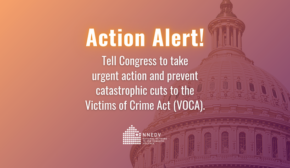One Size Does NOT Fit All: Diverse Housing Options for Survivors in the United States
August 5, 2016
This article originally appeared in the Summer 2016 issue of Homeless in Europe
By: Ashley Slye, NNEDV Transitional Housing Specialist & Positively Safe Project Manager
A growing number of people in the United States are homeless or are on the verge of homelessness for a variety of reasons. For survivors of violence against women (VAW), most of these reasons are out of their control. For survivors that leave an abusive partner, it is very likely that she and her children will face homelessness.
Many survivors have nowhere to go, as they have been isolated from their support system by their partner. They face an uphill battle of dealing with destroyed credit or a spotty employment history due to the abuse they have endured, and sometimes continue to endure. [1] And this is just the beginning. Expectations around children and family have been placed on women, complicating their decision to leave an abusive partner and address their housing needs. If the woman has a teenage boy, this compounds the situation even further. Sadly, some domestic violence shelters will not admit the survivor because her child looks like an adult man; this denial of shelter can force a survivor to return home to the abuser.
In the United States, women are homeless largely as a result of VAW. Between 22 and 57% of homeless women report that domestic violence was the immediate cause for their homelessness. [2] Domestic violence shelters are often full and homeless shelters may not meet the complex needs of these survivors, further traumatizing them. Our social services and public assistance systems have truly let them down.
Day in and day out, VAW advocates see the mountains these survivors are challenged with climbing. Society expects a survivor to “just leave.” Unfortunately, this is not always realistic. Leaving an abusive relationship is often the most dangerous time for a survivor. [3] The economic abuse by abusive partners places them in poverty, and the lack of a support system and safe places to go if they are able to leave leads them down the path to homelessness.
The United States has a public/social housing system that provides housing based on availability rather than eligibility. Many people qualify for subsidized housing, but are never granted the benefit because of the sheer lack of resources. Waiting lists are often three, four, or even five years long. Public/social housing is being torn down, never to be replaced. It is in this environment that our housing spectrum has developed. Due to the continued affordable and subsidized housing crisis in the United States, NGOs have begun implementing the Housing First philosophy, providing individuals with a home first, regardless of the barriers they face, and then addressing the issues around their homelessness. Individuals should be offered supportive services that meet their personal needs. [4] This philosophy sees housing as a human right, not a reward for completing a program or maintaining sobriety.
Domestic violence NGOs are long-term supporters of Housing First. Many of the initial Housing First programs were started by VAW NGOs, like Home Free in Portland, OR. The Washington State Coalition Against Domestic Violence has also been vocal in Housing First for many years and is often called upon as an expert. Before Housing First became a “hot topic,” domestic violence advocates were figuring out the best ways to get survivors into safe housing, as well as address the barriers keeping them from obtaining and maintaining their own housing, by implementing a wide range of housing models, from emergency shelter to permanent housing and everything in between.
Housing First in the United States is most often discussed in connection with rapid re-housing (RRH) and permanent supportive housing (PSH), as these models directly link individuals to permanent housing. RRH is a housing model that moves individuals from homelessness to housing in the community, providing rental assistance for a period of time, typically 3-6 months but sometimes more, after which the resident begins paying their own rent. PSH, on the other hand, is a housing model in which individuals are housed for an extended period of time, with no expiration date, in an apartment that is managed by an organization. PSH is typically reserved for those who are chronically homeless, but may be beneficial for those with other long-term needs, such as people with disabilities or chronic health issues. Both housing models also provide individuals with supportive services to address the issue(s) that lead to their homelessness.
Because of the unique safety needs of survivors, many domestic violence NGOs across the United States have also implemented transitional housing under three distinct models. A scattered model secures housing in the community that is rented by the organization or the individual, much like RRH, and the NGO pays the rent to the landlord. A clustered model houses multiple survivors in one building, with each survivor/family in their own private apartment/flat, typically owned by the NGO. Lastly, a communal model houses survivors in one building; each individual has their own private bedroom (and sometimes bathroom) but living spaces, such as a kitchen and living room, are shared. Each of these models provide supportive housing, financially and programmatically, for up to 24-months.
For almost two decades now, survivors have benefited from transitional housing. Survivor success stories range from maintaining sobriety to going back to school to obtain a university degree. Through the federal Violence Against Women Act (VAWA), as well as the U.S. Department of Housing & Urban Development, NGOs have been able to apply for grants to support transitional housing. The U.S. National Network to End Domestic Violence’s Transitional Housing Program supports VAWA-funded programs to strengthen their service delivery, identify gaps in services, and detect emerging challenges. For six years I have been involved with this work at NNEDV and have seen tremendous change in programs – the growth of staff, improvement of services, and the expansion of partnerships that have contributed to the success and safety of so many survivors.
So, does transitional housing fit into the Housing First philosophy? Scattered site transitional housing programs offer individuals the opportunity to remain in their apartment/flat after the program ends. Communal and clustered transitional housing programs do not provide permanent housing. However, they do provide housing, safety, and support for survivors so they can obtain permanent housing when they are prepared, and in this model, safe housing comes first. Domestic violence transitional housing accepts survivors regardless of the barriers they face, and employs a trauma-informed, survivor-driven, voluntary approach to services.
For some survivors, the added safety of living in a building owned by a VAW organization has been critical to their success. One goal of the VAW field is to increase the safety of survivors, and a main objective of that is to locate safe, affordable housing. Each of the above-mentioned housing programs offer survivors different options and paths to reaching this goal. However, moving survivors that may still be in a state of trauma or have safety concerns to housing across their community too quickly may end up compromising their safety. For some survivors, this is an option, but for others longer term support may be needed. For those that are not ready to move into an apartment in the community, shelter should not be used as a holding space for survivors; transitional housing can provide both housing and support for these survivors.
Because the needs and experiences of each survivor are unique, we must listen to them. Listen to their instincts and their concerns. NGOs must develop programming that respects all survivors and allows them to choose their own direction. Mandating that survivor participate in services re-creates the dynamics of power and control , leaving survivors feeling disrespected, like they have moved from one controlling situation to another. [5] Constant review of agency rules and services is essential in the implementation of trauma-informed, survivor-driven housing programs. Each survivor has their own story, barriers, and successes that will impact their housing needs. As advocates, it is our duty to stand with them in support as they decide what is best for them, not to lead them on the road we see fit or dictate to them.
I won’t advocate for one housing model over another. However, I will advocate for diverse housing options that meet the individual needs of each survivor, as well as providing trauma-informed, survivor-driven, voluntary services. There will be survivors who will need Permanent Supportive Housing, those who need six months of rental assistance, those who just need a short-term stay in an emergency shelter, and others that fall in between all of these. Unfortunately, in the United States, the National Intimate Partner and Sexual Violence survey, conducted by the Centers for Disease Control and Prevention, found that 51.5% of survivors who identified a need for housing services did not receive them. [6] NGOs must expand their housing options and evaluate if they are actually meeting the housing and service needs of survivors. We need to ask them. We need to listen.
—
[1] Violence Against Women Act and Department of Justice Reauthorization Act of 2005, Pub. L. No. 109-162, § 41401, 119 Stat. 2960 (2005).
[2] https://nnedv.org/downloads/Policy/NNEDV_DVHousing__factsheet.pdf
[3] http://www.thehotline.org/2013/06/50-obstacles-to-leaving-1-10/
[4] https://www.usich.gov/tools-for-action/housing-first-checklist
[5] A. Melbin, C. Sullivan, D. Cain. Transitional Supportive Housing Programs: Battered Women’s Perspective and Recommendations. 2003. Sage Publications.
[6] Intimate Partner Violence in the United States – 2010. The National Intimate Partner and Sexual Violence Survey. http://www.cdc.gov/violenceprevention/pdf/cdc_nisvs_ipv_report_2013_v17_single_a.pdf





